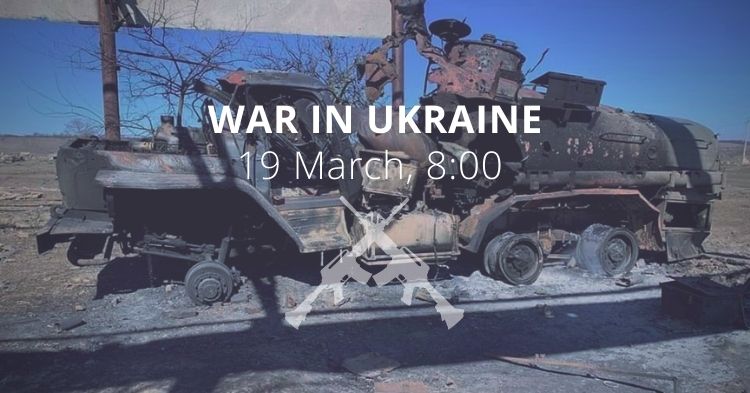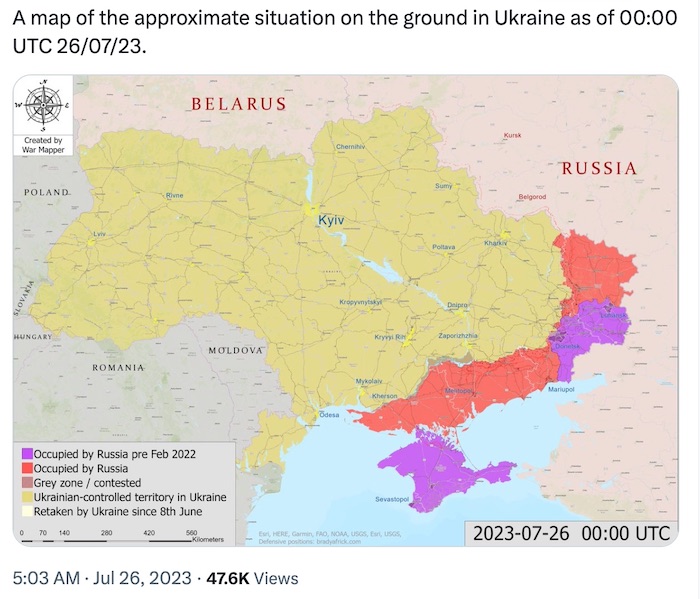

- Volyn and Polissya axes: no significant changes.


- Sivershchyna and Slobozhanshchyna axes: the adversary continues to maintain its military presence. The occupant forces launched airstrikes in the vicinities of Veterynarne and Hraniv (Kharkiv oblast). The adversary fired mortars and artillery at more than 20 settlements, including Semenivka (Chernihiv oblast), Vil’na Sloboda, Svarkove, Stepne, Basivka, Mohrytsya, Pokrovka, Oleksandrivka (Sumy oblast), Hur’yiv Kozachok, Hraniv, Vovchans’k, Bochkove, Budarky (Kharkiv oblast).
- Kupiansk axis: the Ukrainian troops are standing their ground. The adversary launched an airstrike in the vicinity of Novoselivs’ke (Luhansk oblast). Krasne Pershe, Dvorichna, Zapadne, Kup’yans’k, Kyslivka, and Berestove (Kharkiv oblast) came under artillery and mortar fire from the adversary.

- Lyman axis: the adversary conducted unsuccessful offensives in the area south of Dibrova (Luhansk oblast). The invaders launched airstrikes in the vicinities of Bilohorivka (Luhansk oblast), Serebryanka, Spirne, and Kuz’mynivka (Donetsk oblast). The settlements of Nevs’ke, (Luhansk Oblast), Tors’ke, Verkhn’okam’yans’ke, Spirne, and Rozdolivka (Donetsk Oblast) were shelled with artillery.
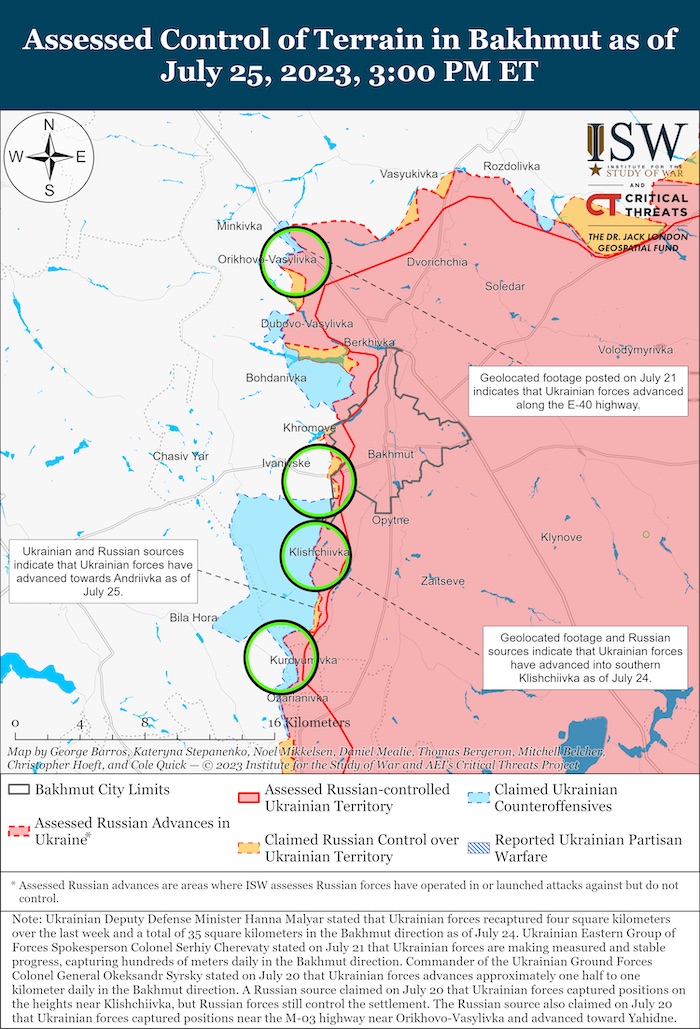
- Bakhmut axis: the Ukrainian defenders successfully repelled adversary attacks in the areas east of Stupochky and near Dyliivka (Donetsk oblast). The enemy launched airstrikes in the vicinities of Klishchiivka, Predtechyne, and Dyliivka (Donetsk oblast). More than 10 settlements, including Vasyukivka, Orikhovo-Vasylivka, Bohdanivka, Ivanivske, Chasiv Yar, and Pivnichne (Donetsk oblast), suffered from enemy artillery shelling.
- Avdiivka axis: under heavy fire from enemy aircraft and artillery, the Ukrainian defenders successfully repelled Russian troops’ attacks in the vicinity of Avdiivka. At the same time, the enemy fired artillery at more than 10 settlements, including Novokalynove Avdiivka, Lastochkyne, Vodyane, and Karlivka, (Donetsk oblast).
- Marinka axis: the Ukrainian Defence Forces continue to hold back the Russian offensive in the vicinity of the city of Marinka. The enemy launched airstrikes near Nevelske and Krasnohorivka. The settlements of Krasnohorivka, Maksymil’yanivka, and Heorhiivka (Donetsk oblast) came under artillery fire.
- Shakhtarske axis: the adversary launched airstrikes in the vicinities of Novomykhailivka, Zolota Nyva, and Makarivka (Donetsk oblast). The occupiers shelled more than 10 settlements, including Novomykhailivka, Vuhledar, Novoukrainka, and Velyka Novosilka (Donetsk oblast).

- Zaporizhzhia and Kherson axes: the adversary focuses its main efforts on preventing the further advance of Ukrainian troops. The invaders launched airstrikes in the vicinities of Novodarivka, Levadne, Mala Tokmachka, and Orikhiv (Zaporizhzhia oblast). The enemy fired artillery at more than 30 settlements, including Novoandriivka, Levadne, Malynivka, Hulyaipole, Zaliznychne, Stepove, Lobkove, Kam’yans’ke (Zaporizhzhia oblast), Dudchany, Beryslav, Kozats’ke, Molodizhne, Antonivka, Komyshany, Kizomys, and Stanislav (Kherson oblast). At the same time, the Ukrainian Defense Forces continue to conduct the offensive operation on Melitopol’ and Berdyans’k axes, consolidating their positions.
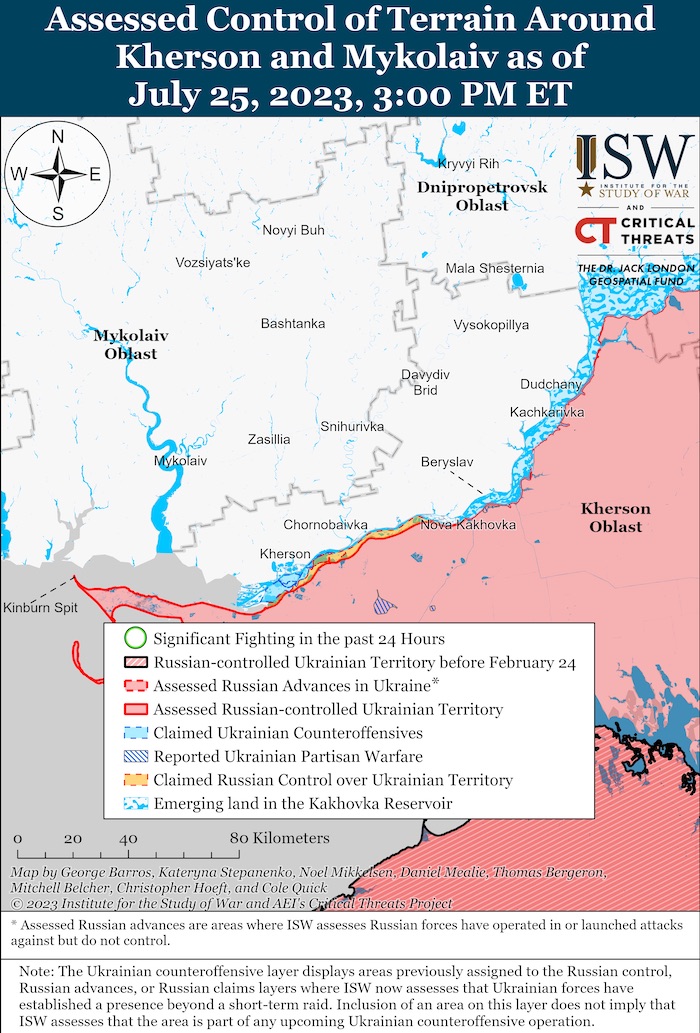
Military Update
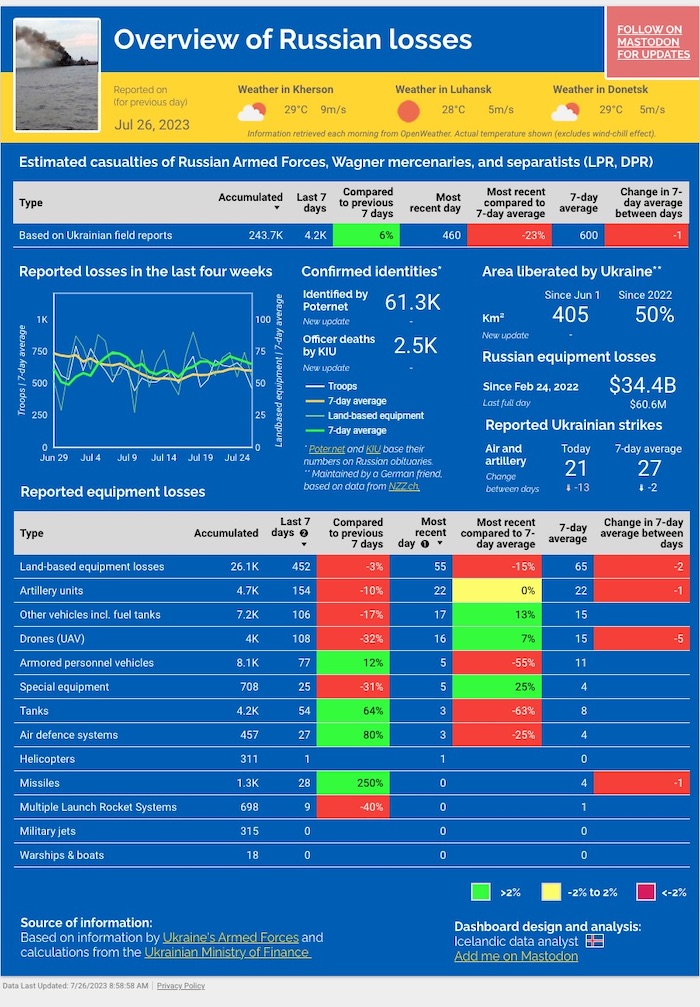
- Russia’s Black Sea Fleet has altered its posture since Russia pulled out of the Black Sea Grain Initiative (BSGI), in preparedness to enforce a blockade on Ukraine.
- The modern corvette SERGEY KOTOV, has deployed to the southern Black Sea, patrolling the shipping lane between the Bosphorus and Odesa. There is a realistic possibility that it will form part of a task group to intercept commercial vessels Russia believes are heading to Ukraine.
- The BSGI has moderated the involvement of the Black Sea in the war: there is now the potential for the intensity and scope of violence in the area to increase.
- Since 18 July 2023, Russia has conducted greater numbers of long-range strikes against Odesa and other areas of southern Ukraine. These attacks have featured an unusual number of AS-4 KITCHEN missiles, a 5.5 tonne weapon originally designed to destroy aircraft carriers.
- Damage has included several grain silos at Chornomorsk Port, south of Odesa, as well as the historic city centre. On 24 July 2023, Russia extended one way attack drone strikes to the docks on the Danube River, approximately 200 metres from the Romanian border.
- Between August 2022 and June 2023, when the Black Sea Grain Initiative was still in force, Russia generally refrained from striking civil infrastructure in the southern ports. Since Russia failed to renew the deal, the Kremlin likely feels less politically constrained, and is attempting to strike targets in Odesa because it believes Ukraine is storing military assets in these areas. Since the start of the war, Russia's strike campaign has been characterised by poor intelligence and a dysfunctional targeting process.
Losses of the Russian army
As of Wednesday 26 July, the approximate losses of weapons and military equipment of the Russian Armed Forces from the beginning of the invasion to the present day:Russia's estimated losses as of day 518 of its full-blown invasion of Ukraine. pic.twitter.com/KrLH3iqfkJ
— Euromaidan Press (@EuromaidanPress) July 26, 2023
- Personnel – about 243680 (+460)
- Tanks – 4177 (+3)
- Armoured combat vehicles – 8136 (+5)
- Artillery systems – 4727 (+22)
- Multiple rocket launchers –MLRS - 698 (+0)
- Air defence means – 457 (+3)
- Aircraft - 315 (+0)
- Helicopters - 311 (+1)
- Automotive technology and fuel tanks – 7211 (+17)
- Vessels/boats - 18 (+0)
- UAV operational and tactical level – 3993 (+16)
- Special equipment – 708 (+5)
- Mobile SRBM system – 4 (+0)
- Cruise missiles – 1307 (+0)
Humanitarian
Russia's Danube attacks tighten noose on Ukraine's grain sector, Reuters reports. “Russian airstrikes on Ukrainian grain facilities on the Danube this week threaten a vital river route for Kyiv's exports, as Moscow seeks to tighten the noose around a key sector of the economy days after abandoning the Black Sea shipping deal. Last week, airstrikes caused tens of millions of dollars of damage to the grain sector in Odesa region, and Monday's strikes on infrastructure along the Danube brought back memories of the export gridlock that followed Russia's February 2022 invasion. Without the Danube, the export (situation) becomes critical. To do it with just land routes is a very small amount. We'd be going back to the beginning of the full-scale invasion, said Denys Marchuk, deputy head of the Ukrainian Agrarian Council. We have no other way to work. If the Black Sea is closed, the Danube is one of the main routes which we will need to use, he told Reuters by phone. Police said Danube grain warehouses had been hit on Monday in a drone attack along with tanks for storing other cargo. Reuters verified video showing damaged grain warehouses at Reni, a transport hub on the Danube bordering NATO and EU member Romania. […] Insurance sources have said war risk cover for Ukraine's ports that was part of the defunct Black Sea grain deal had been suspended with some insurance providers reviewing provisions for Danube ports. Insurance industry sources said on Tuesday there were few requests to cover new charters for vessels looking to pick up cargoes from Ukraine’s Danube ports. […] The Danube corridor has grown in importance for Kyiv since the demise of the grain deal which Russia quit last week. The route could export around 2.5 million tons of grain and oilseeds per month before the attacks, according to Mera. Road and rail export routes would only be able to handle up to 2 million tons of produce per month, Marchuk said. That is nowhere near enough to cover Ukraine's export potential. Ukraine expects to harvest 44 million tons of grain this year, down from a record 86-million-ton harvest in 2021 before the invasion. Ukraine traditionally exports most of the grain it harvests. Some of Ukraine's western neighbours have also restricted imports of Ukrainian grain under pressure from their farmers, who said they were suffering from the added competition. The attack on the Danube infrastructure followed a week of Russian strikes that hit grain-related infrastructure at Odesa's main ports.” Ukrainian Defence Intelligence reveals secret report for Kremlin on how Russia disrupted grain deal, Ukrainska Pravda reports, citing Defence Intelligence of Ukraine . “Defence Intelligence has published a classified report for Russia's top military and political leadership, which contains information on the obstruction of the grain deal. In general, the text of the document is devoted to the technologies used to impede the implementation of the grain corridor and, as a result, led to the final breakdown of the agreement. According to the report, the so-called "joint coordination centre" saw its main task as minimising the volume of grain exported under the grain agreement. In particular, the document states: "High-quality inspection of vessels was also one of the key elements in curbing the uncontrolled growth of grain exports from Ukrainian ports. The activities of the Russian inspectors were conducted in strict accordance with the developed methodological documents on the organisation of ship inspections. As a result of the inspections, 46 vessels were restricted from participating in the Initiative, and 303 vessels were restricted for a total of 342 days". The measures to disrupt the Black Sea Grain Initiative were divided into several stages. At the first stage, on the initiative of the Russian president, Russia's participation in the grain agreement was suspended from 10 October 2022 to 3 November 2022. According to the document, this led to a drop in grain exports from 4.2 million tonnes in October to 2.6 million tonnes in November. The next stage included measures to restrict the access of ships to the port of Pivdennyi, reduce the number of inspection teams (no more than two), and stop the registration of grain carriers. This allowed Russians to effectively restrain the number of ships heading to Ukrainian ports and significantly limit the volume of food exports from Ukraine, which in general led to Kyiv's inability to export about 20 million tonnes of cargo. Russians report that "the smallest amount of food exported from Ukrainian ports (7.8 million tonnes) occurred during the third stage of the Black Sea Grain Initiative (from 19 March to 17 July 2023). Special attention was paid to the disruption of grain supplies under the World Food Programme: "Ukrainian attempts to use the Black Sea Initiative to continue the so-called ‘Grain from Ukraine’ programme involving vessels chartered under the World Food Programme have been stopped. Such vessels were registered only after submitting written commitments not to participate in such actions". The authors of the report conclude: "The accumulated archive of knowledge will allow, when solving similar problems, to achieve a high level of efficiency in the shortest possible time". The Ukrainian Defence Intelligence believes that if the grain agreement is extended, Russians will use all the accumulated "experience" to effectively disrupt the agreements. The Ukrainian agency believes that the document shows that all actions to disrupt the grain deal are part of a single, pre-designed plan, and the targeted shelling of Ukrainian port infrastructure is just another step in its implementation.”Environmental
US State Department reacts to IAEA information about mines at Zaporizhzhia Nuclear Power Plant, Ukrainska Pravda reports, citing Ukrinform, quoting Vedant Patel, Principal Deputy Spokesperson of the US Department of State. “The US State Department is calling for an end to hostilities in the immediate vicinity of the Zaporizhzhia Nuclear Power Plant (ZNPP), as the mining of the nuclear facility threatens the security of the entire region. Such a violent and volatile type of activity near, in such close proximity to, a nuclear power plant – in this case, ZNPP – is incredibly unsafe. Patel was commenting on the issue of the United States’ position on the IAEA's announcement that landmines have been found on the territory of the ZNPP. Patel stressed that this puts the immediate region in harm’s way. And so we continue to call for such activity so close to ZNPP to stop, the State Department representative said. The US has warned the Kremlin of imminent liability if Russia creates a nuclear disaster at the ZNPP.” Zaporizhzhia nuclear plant makes shutdown transition for maintenance, Reuters reports. “Operators carrying out maintenance at Ukraine's Zaporizhzhia nuclear plant have switched the shutdown mode of two reactors, the Moscow-installed administration of the plant, located on the war's front-line, said on Tuesday. […] One of the plant's six reactors, according to the IAEA, needs to be kept in a hot shutdown mode in order to produce steam required for nuclear safety, including the processing of liquid radioactive waste in storage tanks. In order to conduct a scheduled technical inspection of the equipment of power unit No. 5, the management of the Zaporizhzhia nuclear power plant decided to transfer it to the 'cold shutdown,' state, the administration said on its Telegram channel. And in order to provide steam for the station's own needs, the reactor plant of power unit No. 4 was transferred to the 'hot shutdown' state. The IAEA said in a statement on Monday that the plant administration had informed the agency about the transition. The other units remain in cold shutdown, the IAEA said in the statement. […] IAEA inspectors stationed at the plant had noted mines in a buffer zone between the site’s internal and external perimeter barriers and had also observed mines during previous checks, Rafael Grossi, the agency's director general, said on Monday.” Occupants put Zaporizhzhia NPP Unit 4 on "hot shutdown" – Energoatom, Censor.net reports. “On July 24, at the occupied Zaporizhzhia Nuclear Power Plant, power unit No. 4 was put on "hot shutdown" by order of the illegitimate management. This was stated by Energoatom. Such actions of the occupiers are a gross violation of the requirements of the license to operate this nuclear facility. Now the operation of ZNPP Unit 4 should be carried out exclusively in a cold shutdown state, Energoatom noted. Energoatom recalled that after Russia blew up the dam of the Kakhovka hydroelectric power plant and the actual disappearance of the Kakhovka reservoir, there were real risks of insufficient cooling water supply to the Zaporizhzhia nuclear power plant. This blocks the ability of ZNPP to operate at capacity, and the Russian occupation administration of the plant and representatives of Rosatom are aware of this. This means that it is an undeniable risk to nuclear and radiation safety due to the long downtime of the power unit's equipment, lack of proper routine maintenance and repair of equipment. Petro Kotin, President of Energoatom, addressed the Ministry of Foreign Affairs of Ukraine, emphasizing the need to call on the IAEA to take measures to influence the occupation administration of ZNPP to put all power units of the plant into a cold shutdown state and to distribute a corresponding note among the Agency's member states.”Legal
Russians completely ruin 180 schools in Ukraine, Ukrinform reports, citing Ukrainian Education and Science Minister Oksen Lisovyi. “Today we have 180 schools that have been ruined completely. More than 300 educational institutions were destroyed, and over 1,300 damaged and liable to expert assessment, whether they can be rebuilt or not,” Lisovyi told. In his words, the Ukrainian government allocated UAH 1.5 billion to set up bomb shelters before the next academic year starts. Three-quarters of schools have bomb shelters of different level and quality. 75% of schools are provided with bomb shelters, but this does not mean that 75% of pupils can resume studies. It is about 9,000 schools, and we have 13,000 schools in total. Our priority is to resume [offline] studies, where it is allowed for security reasons. In the regions close to the areas of hostilities, classes will be conducted online, Lisovyi noted. In order to improve the quality of education, the ministry recommends that higher educational institutions also resume offline studies, where the security situation allows. Many of such institutions can set up bomb shelters architecture-wise, but sometimes they are not spacious enough to accept all students. Another issue, according to Lisovyi, may be the migration of teachers. This may also create obstacles for the resumption of offline studies. Hence, the management of each educational institution will decide on the start of offline studies on its own.”Support
Biden Administration Announces Additional Security Assistance for Ukraine, the US Department of Defence announces. “Today, the Department of Defense (DoD) announced additional security assistance to meet Ukraine’s critical security and defense needs. This authorization is the Biden Administration’s forty-third drawdown of equipment from DoD inventories for Ukraine since August 2021 as the US government has continuously provided Ukraine with the weapons and equipment it needs for the battlefield. Today’s commitment in security assistance, valued at up to $400 million, includes additional air defense munitions, artillery and other ammunition, armored vehicles, anti-armor weapons, and other equipment to help Ukraine counter Russia’s ongoing war of aggression. The capabilities in this package include additional munitions for Patriot air defense systems and National Advanced Surface-to-Air Missile Systems (NASAMS); Stinger anti-aircraft systems; additional ammunition for High Mobility Artillery Rocket Systems (HIMARS); 155mm and 105mm artillery rounds; 120mm and 60mm mortar rounds; 32 Stryker Armored Personnel Carriers; Tube-Launched, Optically-Tracked, Wire-Guided (TOW) missiles; Javelin and other anti-armor systems and rockets; Hornet Unmanned Aerial Systems; Hydra-70 aircraft rockets; Tactical air navigation systems; Demolitions munitions for obstacle clearing; over 28 million rounds of small arms ammunition and grenades; Night vision devices and thermal imagery systems; and spare parts, training munitions, and other field equipment. The United States will continue to work with its Allies and partners to provide Ukraine with capabilities to meet its immediate battlefield needs and longer-term security assistance requirements.” Ukraine calls on partners to strengthen air shield over south – PM, Ukrinform reports. “Prime Minister Denys Shmyhal called on international partners to help Ukraine strengthen its air defences in the southern regions. He said this at the government meeting on Tuesday, an Ukrinform correspondent reports. Russia is a threat to all states in the Black Sea region. We call on our partners to strengthen the air shield over the south of Ukraine, Shmyhal noted. He emphasized that Russia has been terrorizing the southern regions of Ukraine for more than a week. According to him, the aggressor’s goal is to intimidate people, destroy Ukrainian port infrastructure, cause maximum damage to Ukrainian agricultural exports, and provoke a global food crisis.” Zelenskyy: Good news about drones will be more frequent, Ukrainska Pravda reports, citing Zelensky’s evening address. “President Volodymyr Zelenskyy has said that the results of the first year of the Army of Drones are now available and can be seen in the news, and good news about the use of drones will be appearing more often. Today, a non-public but still strategically important event took place: government officials presented the results of the first year of the Army of Drones. It’s not just a project anymore, but a real Ukrainian drone army." Zelenskyy said there had been a presentation of the various types of Ukrainian drones used for defence, as well as a meeting with manufacturers, designers and donors. Zelenskyy emphasised that the Army of Drones will increase, as the Armed Forces need all types of drones – from fairly simple Mavic drones to naval and attack drones that are capable of operating at long distances.” Arms export for Ukraine’s sake: Japan PM calls for speeding up internal talks, Ukrinform reports, citing Kyodo News. “Japan's Prime Minister Fumio Kishida has instructed ruling parties to speed up discussions on easing the country's strict rules on military exports, as the government seeks to strengthen the domestic defence industry and expand support for Ukraine in its fight against Russian encroachment. Kishida told working group lawmakers of his Liberal Democratic Party and its junior coalition partner Komeito that his government would soon present its views on defence equipment and technology exports and asked them to resume stalled talks on the issue. […] Japan's Chief Cabinet Secretary Hirokazu Matsuno said the government and the ruling bloc would work together to create the desired security environment for Japan and establish rules to support countries that have been invaded militarily, calling the export of defence equipment an important political tool. As Ukrinform reported earlier, at the beginning of July it became known that the ruling coalition in Japan intended to propose that the country's parliament review the current restrictions on the export of defence equipment and to allow the transfer of weapons to countries that have been invaded by other states in violation of international law.” Ukraine to receive US$240 million and mine clearance equipment, Ukrainska Pravda reports, citing Yuliia Svyrydenko, First Deputy Prime Minister and Minister of Economic Development and Trade of Ukraine. “Ukraine’s international partners will give it over US$244 million for humanitarian mine clearance. […] By the end of this year, Ukraine is set to receive [mine clearance] equipment from its international partners, including 10 much-needed demining machines from the Croatian company DOK-ING, 10 Global Clearance Solutions machines, nearly 200 vehicles for explosives experts, over 600 metal detectors, and 50 blasting machines, Svyrydenko wrote on Facebook. Ukraine will also receive individual mine clearance kits, explosive protective suits, quadcopters, and robotic systems for the disposal of ammunition. Donors from across the world include the US, the EU, Japan, Germany, the UK, Norway, Sweden, Italy, Lithuania, the Netherlands, Denmark, Canada, Austria, Switzerland, Korea and the Howard Buffett Foundation, and will give Ukraine more than US$244 million for humanitarian mine clearance.” European Commission paid new tranche worth 1.5 billion euros of macro-financial assistance to Ukraine, European Pravda reports. “On Tuesday, the European Commission announced the allocation of 1.5-billion-euro tranche of macro-financial aid to Ukraine. […] As Russia continues its ruthless war, we continue to support Ukraine. Today we paid another €1.5 billion, to help keep the state running and repair infrastructure. More will come, stated von der Leyen on Twitter. Ukraine received the first tranche of EU macro-financial assistance in January, totalling 3 billion euros out of a planned 18 billion euros. The previous tranche was disbursed by the European Commission in June. The decision on this €18 billion aid package was a difficult one, and EU leaders finally reached an agreement in mid-December. Kyiv received the first tranche without any conditionality. However, according to the agreement, Ukraine will receive the next €15 billion only if it fulfils its obligations. Macro-financial assistance is a loan provided to Ukraine at a favourable interest rate.”New developments
- Ukraine's Foreign Minister calls blockade of Ukrainian grain in EU unacceptable, Ukrainska Pravda reports, citing France24. “Dmytro Kuleba, Ukraine’s Minister of Foreign Affairs, considers unacceptable the intentions of individual EU countries to extend the restrictions on the import of Ukrainian grain after 15 September. […] We should not play into the hands of Putin; we should not play his game. […] Kuleba stressed that Russia is destroying the grain infrastructure of Ukraine, in particular, because it wants to provoke additional tensions between Ukraine and its western neighbours.”
- Belarus arms emergency ministry to be ready in case of armed conflict, Reuters reports. “The Belarusian ministry of emergency situations is completing the arming and military training of its personnel to be ready to aid the defence and internal ministries in the event of an armed conflict, the head of the emergency ministry said on Monday. Emergency Minister Vadim Sinyavsky told state Belarus 1 television that employees will be ready to assist the ministries in the event of an armed conflict or some kind of riots in which a significant number of personnel must be involved. […] Russia and Belarus are linked in a partnership called the "union state" in which Moscow is by far the dominant player. The perception that Lukashenka, a pariah in the West, depends on Putin for his survival had fanned fears in Kyiv that Putin would pressure him to join a fresh ground offensive and open a new front in Russia's faltering invasion of Ukraine."
- "Tough retaliation measures": Russia responds to attacks on Moscow and Crimea, Ukrainska Pravda reports, citing a statement released by the Foreign Affairs Ministry of the Russian Federation. “The Foreign Affairs Ministry of the Russian Federation has said it will take tough retaliation measures in light of the recent attacks on Moscow and Russian-occupied Crimea. The Russian side retains the right to undertake tough retaliation measures."
- Russian started war – White House on drone attack on Moscow, Ukrainska Pravda reports, citing Karine Jean-Pierre, White House Press Secretary. "This is a war that Russia started, said Karine Jean-Pierre, responding to a request to comment on the drone attack on Moscow city centre. Karin Jean-Pierre emphasised that the Russian Federation has been striking civilian facilities in Ukraine almost every day during all the months of the war. Russia has been bombarding the Ukrainian port of Odesa; killing and injuring Ukrainian civilians; devastating UNESCO-listed World Heritage Sites; and destroying tens of thousands of tons of grain that were going to be shipped to countries around the world, she said. At the same time, Karin Jean-Pierre noted that the US does not support Ukraine's strike on Russian territory, emphasising that Crimea is Ukrainian territory.”
- Russia extends deadline for repair of Crimean bridge until end of year, Ukrainska Pravda reports, citing Russian Astra Telegram channel with reference to the order published on the website of the Russian government. “The restoration of the bridge after the explosion in October has been extended until 31 December 2023. Previously, the Russians planned to repair it by 1 July. After another attack on 17 July, the Russians planned to finally launch two-way traffic on the Crimean Bridge in November.”
- US responds to Lukashenka's remarks threatening Poland with Wagnerites, Ukrainska Pravda reports, citing Matthew Miller, Spokesperson for the US Department of State during a briefing. “The US Department of State has said that the US will defend NATO territory, commenting on the words of self-proclaimed Belarusian President Aliaksandr Lukashenka, who said that the Wagner Group militants supposedly want to attack Poland. Miller stressed that the US would defend every inch of NATO territory. At the same time, Miller said that the Belarusian leader’s words were another in a series of irresponsible comments by Lukashenka.”
Assessment
- On the War
- Russian President Vladimir Putin continued to manifest concern over potential threats that the Wagner Group and its financier Yevgeny Prigozhin may pose during an impromptu two-day extension of Belarusian President Aliaksandr Lukashenka’s visit to St. Petersburg. Lukashenka likely seeks to leverage his power over the Wagner Group to gain concessions from Putin.
- Russian leadership is attempting to mitigate the security vacuum left by the Wagner Group’s departure by creating formalized but decentralized military “enterprises” on the basis of federal subjects (regions).
- Ukrainian forces continued counteroffensive operations on at least three sectors of the front and advanced on July 25.
- Russian forces conducted another series of Shahed drone strikes on rear areas of Ukraine overnight on July 24-25.
- The Angry Patriots Club continues efforts to cast former Russian officer and ardent nationalist Igor Girkin (Strelkov) as an opposition figure and may be attempting to appeal to Russian President Vladimir Putin through rhetoric about the illegality of Girkin’s arrest.
- Putin and the Kremlin reportedly failed to respond promptly to the Wagner Group’s June 24 rebellion, leaving local Russian officials to make decisions concerning the group’s drive on Moscow.
- Russian forces conducted offensive operations near Svatove, Kreminna, the Bakhmut area, the Avdiivka-Donetsk City area, and the Zaporizhzhia-Donetsk Oblast border area and made claimed advances near Svatove, Kreminna, and Bakhmut.
- Ukrainian forces conducted offensive operations near Kreminna, the Bakhmut area, the Avdiivka-Donetsk City area, along the administrative border between Zaporizhzhia and Donetsk oblasts, and western Zaporizhzhia Oblast and advanced in the Bakhmut area, in some areas along the administrative border between Zaporizhzhia and Donetsk oblasts, and west of Orikhiv.
- US intelligence officials warned on July 25 that Russia’s drone supply will dramatically increase as a result of continued bilateral Russo-Iranian cooperation.
- Russian officials continue efforts to deconflict legal discrepancies as part of the incorporation of occupied territories.“
- Consequences and what to do?


